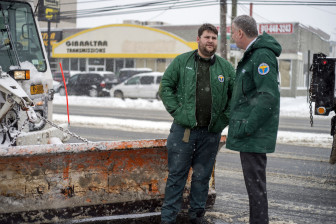
Frederick Joseph
It is said that governments often make the mistake of fighting the last war. Maybe that’s true of snowstorms, too—especially when the forecasters say it’s going to be the worst war/blizzard ever. While nothing in the city’s after-action report on the 2010 blizzard explicitly calls for the governor to shut down the transit system with nary a heads-up to the mayor, little else about the city and state responses to this week’s Fizzard (or No-storm, or the Great White Nope—you are free to use any of those gems in weekend conversations, with my compliments) departs from the lessons learned from that post-Christmas storm five years ago, where the city’s late and lackluster response was reflected in buses strewn across streets and passengers stranded on trains.
The question now is what will happen when the next serious storm bears down on the five boroughs. In an interesting report on the nuances of snow-response costs—and really, could there ever be an un-interesting report about such a topic?—Comptroller Scott Stringer this week noted that the two recent fiscal years that had the highest costs per inch of snow featured “a large storm, early in the season and public criticism of that storm’s cleanup.” The report adds: “A key indicator of avoiding above average costs seems to be an effective cleanup of the first storm.”

Ed Reed/Mayoral Photography Office
Mayor Bill de Blasio meets with Sanitation Workers.
We’ll find out next time the fluffy stuff falls. In case that comes in the form of a freak blizzard this weekend, here’s some other reading to plow through while you wait for the plows to rescue you:
1) 421-a: The super-boring name is just part of the problem
In a year in which the future of affordable housing in New York City will hinge on action in Albany on rent regulations and at the Department of Housing Preservation and Development on the mayor’s housing plan, 421-a is the policy debate that links them together. Authorized by the state but administered locally, the tax break was set up to encourage housing construction, something that needs little encouragement these days. Its affordable housing requirements are all but universally agreed to far too weak for the amount of money the city loses on the deal. De Blasio administration officials testifying at a City Council hearing on Thursday were vague on what changes they want to see in 421-a and mum on whether they’d support its renewal if it were not reformed. ANHD is more specific and less restrained in its updated report on this deeply flawed program.
2) Flipping off East New York
New York Magazine visits East New York and reveals a stunning amount of speculation already underway and a little further north in Brownsville, the neighborhood that links the western border of ENY to the rest of rapidly-transforming Brooklyn:
In East New York, the promise of investment has had a perverse effect, pushing land and housing costs higher as speculators try to get in ahead of the redevelopment. According to RealtyTrac, home prices in the redevelopment area’s Zip Codes have risen by 30 to 45 percent over the past two years, and developers say local landowners have recently doubled or tripled asking prices. The more the wave swells, the more expensive it will be to build—and the more elastic the term “affordable” may have to become to meet de Blasio’s goals.
The mayor’s housing plan, which early on named East New York as an area ripe for affordable development, interacts with this wave of real-estate investment in complex ways. It reacts to it, depends on it, encourages it, and will absorb higher costs because of it. (For more coverage of the area, check out our recent reporting on East New York, our coverage of the area back in 2011 and our series on Brownsville during the 2013 campaign.)
3) To be an infant and homeless
A sweeping report by the Center for New York City affairs looks at the unique problems facing—and surprising lack of programs for—very young children growing up homeless and in shelters. “Despite the importance of the early years to lifelong brain development, and despite a growing body of evidence demonstrating the effectiveness of targeted interventions in protecting young children from the traumas common to poverty and homelessness, in the homeless shelter system, there are almost no services designed to meet the particular emotional needs of young children,” the report finds. It’s depressing stuff. One sliver of good news is that the city’s nightly shelter census. appears to be heading down, for the first time in a long time, as new de Blasio administration programs to provide permanent housing kick in.
4) The New Yorker on police violence, Albuquerque-style
“In the five years before Christopher’s death, the Albuquerque Police Department shot thirty-eight people, killing nineteen of them. More than half were mentally ill. In Albuquerque, a city of five hundred and fifty thousand, the rate of fatal shootings by police is eight times that of New York City.” Read this story now.








